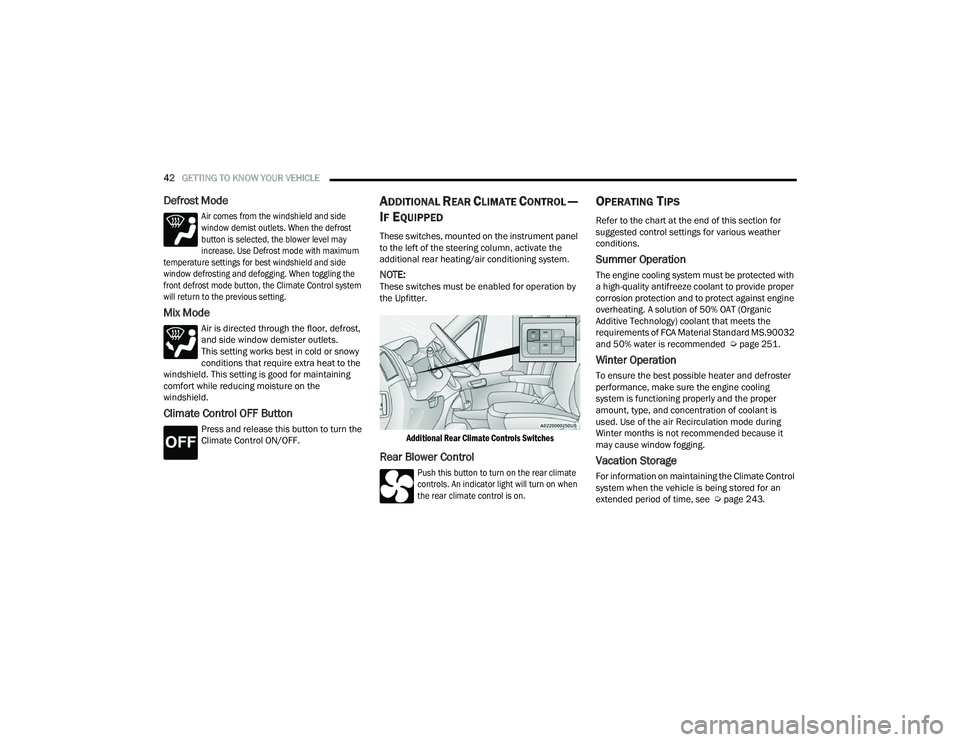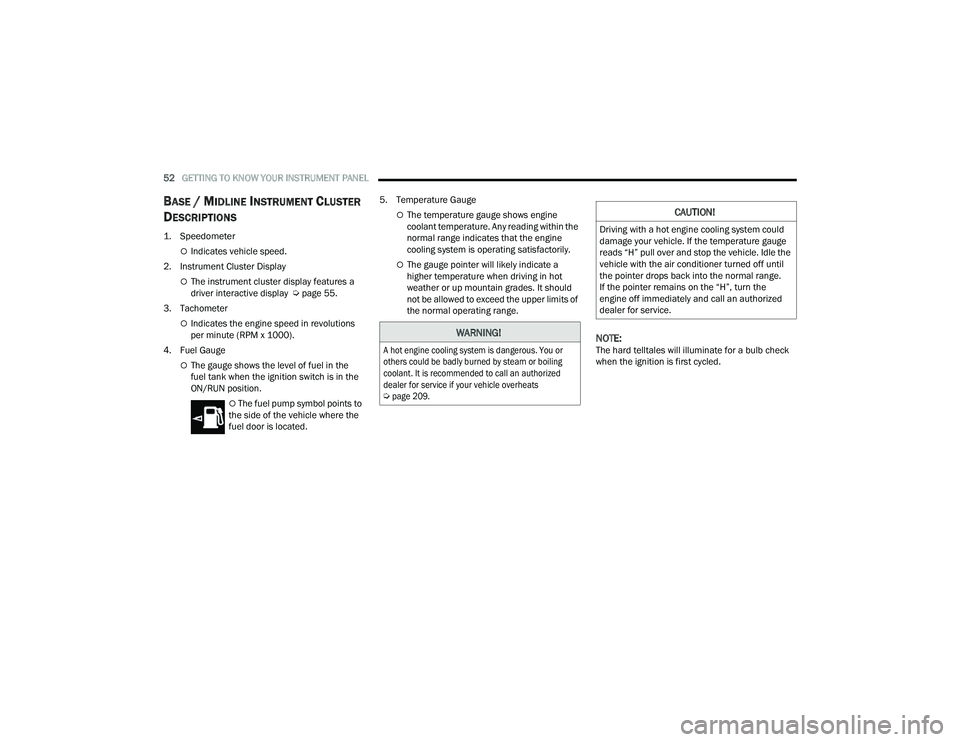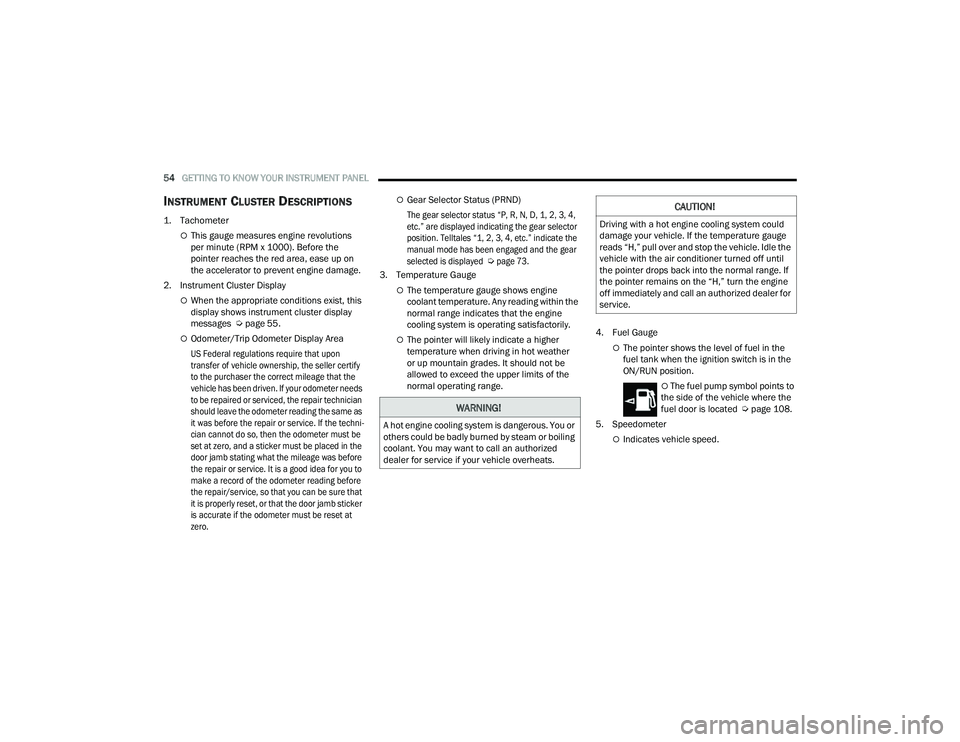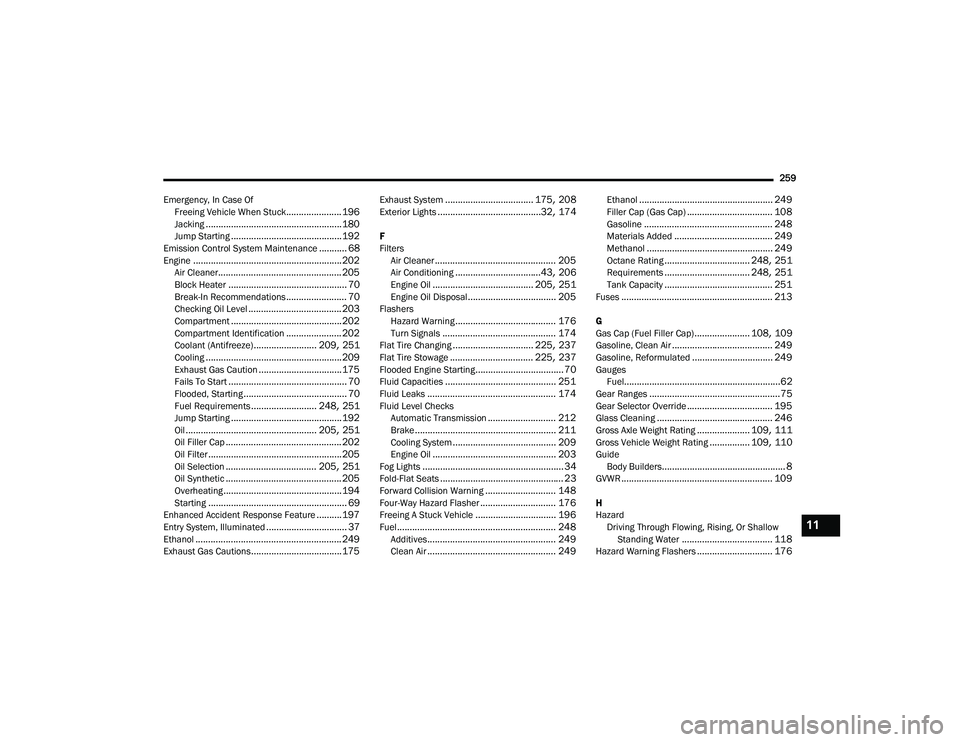coolant level RAM PROMASTER 2022 Owners Manual
[x] Cancel search | Manufacturer: RAM, Model Year: 2022, Model line: PROMASTER, Model: RAM PROMASTER 2022Pages: 268, PDF Size: 13.26 MB
Page 44 of 268

42GETTING TO KNOW YOUR VEHICLE
Defrost Mode
Air comes from the windshield and side
window demist outlets. When the defrost
button is selected, the blower level may
increase. Use Defrost mode with maximum
temperature settings for best windshield and side
window defrosting and defogging. When toggling the
front defrost mode button, the Climate Control system
will return to the previous setting.
Mix Mode
Air is directed through the floor, defrost,
and side window demister outlets.
This setting works best in cold or snowy
conditions that require extra heat to the
windshield. This setting is good for maintaining
comfort while reducing moisture on the
windshield.
Climate Control OFF Button
Press and release this button to turn the
Climate Control ON/OFF.
ADDITIONAL REAR CLIMATE CONTROL —
I
F EQUIPPED
These switches, mounted on the instrument panel
to the left of the steering column, activate the
additional rear heating/air conditioning system.
NOTE:These switches must be enabled for operation by
the Upfitter.
Additional Rear Climate Controls Switches
Rear Blower Control
Push this button to turn on the rear climate
controls. An indicator light will turn on when
the rear climate control is on.
OPERATING TIPS
Refer to the chart at the end of this section for
suggested control settings for various weather
conditions.
Summer Operation
The engine cooling system must be protected with
a high-quality antifreeze coolant to provide proper
corrosion protection and to protect against engine
overheating. A solution of 50% OAT (Organic
Additive Technology) coolant that meets the
requirements of FCA Material Standard MS.90032
and 50% water is recommended Ú page 251.
Winter Operation
To ensure the best possible heater and defroster
performance, make sure the engine cooling
system is functioning properly and the proper
amount, type, and concentration of coolant is
used. Use of the air Recirculation mode during
Winter months is not recommended because it
may cause window fogging.
Vacation Storage
For information on maintaining the Climate Control
system when the vehicle is being stored for an
extended period of time, see Úpage 243.
22_VF_OM_EN_USC_t.book Page 42
Page 54 of 268

52GETTING TO KNOW YOUR INSTRUMENT PANEL
BASE / MIDLINE INSTRUMENT CLUSTER
D
ESCRIPTIONS
1. Speedometer
Indicates vehicle speed.
2. Instrument Cluster Display
The instrument cluster display features a
driver interactive display Ú page 55.
3. Tachometer
Indicates the engine speed in revolutions
per minute (RPM x 1000).
4. Fuel Gauge
The gauge shows the level of fuel in the
fuel tank when the ignition switch is in the
ON/RUN position.
The fuel pump symbol points to
the side of the vehicle where the
fuel door is located. 5. Temperature Gauge
The temperature gauge shows engine
coolant temperature. Any reading within the
normal range indicates that the engine
cooling system is operating satisfactorily.
The gauge pointer will likely indicate a
higher temperature when driving in hot
weather or up mountain grades. It should
not be allowed to exceed the upper limits of
the normal operating range.
NOTE:The hard telltales will illuminate for a bulb check
when the ignition is first cycled.
WARNING!
A hot engine cooling system is dangerous. You or
others could be badly burned by steam or boiling
coolant. It is recommended to call an authorized
dealer for service if your vehicle overheats
Ú
page 209.
CAUTION!
Driving with a hot engine cooling system could
damage your vehicle. If the temperature gauge
reads “H” pull over and stop the vehicle. Idle the
vehicle with the air conditioner turned off until
the pointer drops back into the normal range.
If the pointer remains on the “H”, turn the
engine off immediately and call an authorized
dealer for service.
22_VF_OM_EN_USC_t.book Page 52
Page 56 of 268

54GETTING TO KNOW YOUR INSTRUMENT PANEL
INSTRUMENT CLUSTER DESCRIPTIONS
1. Tachometer
This gauge measures engine revolutions
per minute (RPM x 1000). Before the
pointer reaches the red area, ease up on
the accelerator to prevent engine damage.
2. Instrument Cluster Display
When the appropriate conditions exist, this
display shows instrument cluster display
messages Ú page 55.
Odometer/Trip Odometer Display Area
US Federal regulations require that upon
transfer of vehicle ownership, the seller certify
to the purchaser the correct mileage that the
vehicle has been driven. If your odometer needs
to be repaired or serviced, the repair technician
should leave the odometer reading the same as
it was before the repair or service. If the techni -
cian cannot do so, then the odometer must be
set at zero, and a sticker must be placed in the
door jamb stating what the mileage was before
the repair or service. It is a good idea for you to
make a record of the odometer reading before
the repair/service, so that you can be sure that
it is properly reset, or that the door jamb sticker
is accurate if the odometer must be reset at
zero.
Gear Selector Status (PRND)
The gear selector status “P, R, N, D, 1, 2, 3, 4,
etc.” are displayed indicating the gear selector
position. Telltales “1, 2, 3, 4, etc.” indicate the
manual mode has been engaged and the gear
selected is displayed
Ú
page 73.
3. Temperature Gauge
The temperature gauge shows engine
coolant temperature. Any reading within the
normal range indicates that the engine
cooling system is operating satisfactorily.
The pointer will likely indicate a higher
temperature when driving in hot weather
or up mountain grades. It should not be
allowed to exceed the upper limits of the
normal operating range. 4. Fuel GaugeThe pointer shows the level of fuel in the
fuel tank when the ignition switch is in the
ON/RUN position.
The fuel pump symbol points to
the side of the vehicle where the
fuel door is located Ú page 108.
5. Speedometer
Indicates vehicle speed.
WARNING!
A hot engine cooling system is dangerous. You or
others could be badly burned by steam or boiling
coolant. You may want to call an authorized
dealer for service if your vehicle overheats.
CAUTION!
Driving with a hot engine cooling system could
damage your vehicle. If the temperature gauge
reads “H,” pull over and stop the vehicle. Idle the
vehicle with the air conditioner turned off until
the pointer drops back into the normal range. If
the pointer remains on the “H,” turn the engine
off immediately and call an authorized dealer for
service.
22_VF_OM_EN_USC_t.book Page 54
Page 200 of 268

198
SERVICING AND MAINTENANCE
SCHEDULED SERVICING
Your vehicle is equipped with an automatic oil
change indicator system. The oil change indicator
system will remind you that it is time to take your
vehicle in for scheduled maintenance.
Based on engine operation conditions, the oil
change indicator message will illuminate in the
instrument cluster. This means that service is
required for your vehicle. Operating conditions such
as frequent short-trips, trailer tow, and extremely hot
or cold ambient temperatures will influence when
the “Oil Change Required” message is displayed.
Have the vehicle serviced as soon as possible, within
the next 500 miles (805 km).
An authorized dealer will reset the oil change
indicator message after completing the scheduled
oil change. If a scheduled oil change is performed
by someone other than an authorized dealer, the
message can be reset by referring to the steps
described under Instrument Cluster Display
Ú
page 56.
NOTE:Under no circumstances should oil change
intervals exceed 10,000 miles (16,000 km),
12 months or 350 hours of engine run time,
whichever comes first. The 350 hours of engine
run or idle time is generally only a concern for fleet
customers. Once A Month Or Before A Long Trip:
Check engine oil level
Check windshield washer fluid level
Check the tire pressures and look for unusual
wear or damage. Rotate at the first sign of irreg
-
ular wear, even if it occurs before the oil indi -
cator system turns on
Check the fluid levels of the coolant reservoir,
and brake master cylinder and fill as needed
Check function of all interior and exterior lights
22_VF_OM_EN_USC_t.book Page 198
Page 212 of 268

210SERVICING AND MAINTENANCE
Adding Coolant
The vehicle has been built with an improved engine
coolant (OAT coolant conforming to MS.90032)
that allows extended maintenance intervals.
This engine coolant (antifreeze) can be used up to
10 years or 150,000 miles (240,000 km) before
replacement. To prevent reducing this extended
maintenance period, it is important that you use
the same engine coolant (OAT coolant conforming
to MS.90032) throughout the life of your vehicle.
Please review these recommendations for using
OAT engine coolant that meets the requirements of
the manufacturer Material Standard MS.90032.
When adding engine coolant:
We recommend using Mopar® Antifreeze/
Coolant 10 Year/150,000 Mile (240,000 km)
Formula OAT that meets the requirements of the
manufacturer Material Standard MS.90032.
Mix a minimum solution of 50% OAT engine
coolant that meets the requirements of the
manufacturer Material Standard MS.90032
and distilled water. Use higher concentrations
(not to exceed 70%) if temperatures below
−34°F (−37°C) are anticipated. Please contact
an authorized dealer for assistance.
Use only high purity water such as distilled or
deionized water when mixing the water/engine
coolant solution. The use of lower quality water will reduce the amount of corrosion protection
in the engine cooling system.
NOTE:
It is the owner's responsibility to maintain the
proper level of protection against freezing
according to the temperatures occurring in the
area where the vehicle is operated.
Some vehicles require special tools to add
coolant properly. Failure to fill these systems
properly could lead to severe internal engine
damage. If any coolant is needed to be added to
the system, please contact an authorized dealer.
Mixing engine coolant types is not recom
-
mended and can result in cooling system
damage. If HOAT and OAT coolant are mixed in
an emergency, have an authorized dealer drain,
flush, and refill with OAT coolant (conforming to
MS.90032) as soon as possible.
Cooling System Pressure Cap
The cap must be fully tightened to prevent loss of
engine coolant (antifreeze), and to ensure that
engine coolant will return to the radiator from the
coolant recovery tank.
The cap should be inspected and cleaned if there
is any accumulation of foreign material on the
sealing surfaces.
Disposal Of Used Coolant
Used ethylene glycol-based coolant (antifreeze) is a
regulated substance requiring proper disposal. Check
with your local authorities to determine the disposal
rules for your community. To prevent ingestion by
animals or children, do not store ethylene glycol-based
coolant in open containers or allow it to remain in
puddles on the ground. If ingested by a child or pet,
seek emergency assistance immediately. Clean up any
ground spills immediately.
WARNING!
Do not open hot engine cooling system. Never add
engine coolant (antifreeze) when the engine is
overheated. Do not loosen or remove the cap to
cool an overheated engine. Heat causes pressure
to build up in the cooling system. To prevent
scalding or injury, do not remove the pressure cap
while the system is hot or under pressure.
Do not use a pressure cap other than the one
specified for your vehicle. Personal injury or
engine damage may result.
22_VF_OM_EN_USC_t.book Page 210
Page 213 of 268

SERVICING AND MAINTENANCE211
Coolant Level
The coolant expansion bottle provides a quick
visual method for determining that the coolant
level is adequate. With engine off and cold, the
level of the engine coolant (antifreeze) in the bottle
should be between the “MIN” and “MAX” marks.
Cooling System Notes
NOTE:
When the vehicle is stopped after a few miles/kilo -
meters of operation, you may observe vapor coming
from the front of the engine compartment. This is
normally a result of moisture from rain, snow, or high
humidity accumulating on the radiator and being
vaporized when the thermostat opens, allowing hot
engine coolant (antifreeze) to enter the radiator.
If an examination of your engine compartment
shows no evidence of radiator or hose leaks, the
vehicle may be safely driven. The vapor will soon
dissipate.
Do not overfill the coolant expansion bottle.
Check the coolant freeze point in the radiator
and in the coolant expansion bottle. If engine
coolant needs to be added, the contents of the
coolant expansion bottle must also be protected
against freezing.
If frequent engine coolant additions are
required, the cooling system should be pressure
tested for leaks.
Maintain engine coolant concentration at a
minimum of 50% OAT coolant (conforming to
MS.90032) and distilled water for proper corro -
sion protection of your engine which contains
aluminum components.
Make sure that the coolant expansion bottle
overflow hoses are not kinked or obstructed.
Keep the front of the radiator clean. If your
vehicle is equipped with air conditioning, keep
the front of the condenser clean.
Do not change the thermostat for Summer or
Winter operation. If replacement is ever neces -
sary, install ONLY the correct type thermostat.
Other designs may result in unsatisfactory
engine cooling performance, poor gas mileage,
and increased emissions.
BRAKE SYSTEM
In order to ensure brake system performance, all
brake system components should be inspected
periodically Ú page 199.
Fluid Level Check — Brake Master Cylinder
The fluid level of the master cylinder should be
checked when performing under the hood service
or immediately if the Brake System Warning Light
indicates system failure. If necessary, add fluid to
bring level within the designated marks on the side
of the reservoir of the brake master cylinder. Be
sure to clean the top of the master cylinder area
before removing cap. With disc brakes the fluid
level can be expected to fall as the brake linings
wear. However, an unexpected drop in fluid level
may be caused by a leak and a system check
should be conducted Ú page 251.
WARNING!
Riding the brakes can lead to brake failure and
possibly a collision. Driving with your foot resting
or riding on the brake pedal can result in
abnormally high brake temperatures, excessive
lining wear, and possible brake damage. You
would not have your full braking capacity in an
emergency.
8
22_VF_OM_EN_USC_t.book Page 211
Page 259 of 268

257
INDEX
A
Active Driving Assist......................................... 92Active Speed Limiter........................................ 79Adaptive Cruise Control (ACC)
(Cruise Control)................................................ 80Adding Engine Coolant (Antifreeze)............... 210Adding Washing Fluid.................................... 203Additives, Fuel............................................... 249Air Bag........................................................... 162Air Bag Operation...................................... 162Air Bag Warning Light................................ 161Enhanced Accident Response...................197Event Data Recorder (EDR)....................... 197If Deployment Occurs................................ 165Maintaining Your Air Bag System.............. 167Maintenance............................................. 167Side Air Bags............................................. 163Transporting Pets...................................... 173Air Bag Light..................................59, 161, 173Air Cleaner, Engine
(Engine Air Cleaner Filter).............................. 205Air Conditioner Maintenance......................... 206Air Conditioner Refrigerant............................ 206Air Conditioner System.................................. 206Air Conditioning Filter............................. 43, 206Air Conditioning, Operating Tips................ 42, 43
Air Filter........................................................ 205Air PressureTires......................................................... 233AlarmSecurity Alarm...................................... 20, 61Alarm SystemSecurity Alarm............................................. 20Alterations/ModificationsVehicle........................................................... 8Antifreeze (Engine Coolant)................. 209, 251Disposal................................................... 210Anti-Lock Brake System (ABS)...................... 137Anti-Lock Warning Light................................... 61Assist, Hill Start............................................. 140Audio Systems (Radio).................................. 119Auto Down Power Windows............................. 48Auto Up Power Windows.................................. 48Automatic Door Locks...................................... 22Automatic Headlights....................................... 33Automatic High Beams.................................... 33Automatic Transmission.........................73, 213Adding Fluid..................................... 212, 213Fluid And Filter Change............................ 213Fluid Change............................................ 213Fluid Level Check..................................... 212
Fluid Type........................................ 212, 252Special Additives...................................... 212AUX Cord..........................................................44Auxiliary Driving Systems.............................. 142
B
Battery................................................... 60, 204Charging System Light.................................60Keyless Key Fob Replacement....................14Belts, Seat.................................................... 173Blind Spot Monitoring................................... 142Body Builders Guide........................................... 8Body Mechanism Lubrication........................ 207B-Pillar Location............................................ 230Brake Assist System..................................... 138Brake Control System, Electronic.................. 138Brake Fluid........................................... 211, 252Brake System....................................... 211, 247Anti-Lock (ABS)......................................... 137Fluid Check............................................... 211Master Cylinder........................................ 211Parking........................................................71Warning Light...............................................59Brake/Transmission Interlock..........................74Bulb Replacement........................................ 220Bulbs, Light.......................................... 174, 220
11
22_VF_OM_EN_USC_t.book Page 257
Page 260 of 268

258 C
Camera, Rear
...................................... 105, 106Capacities, Fluid............................................ 251Caps, Filler Fuel........................................................... 108Oil (Engine)................................................ 202Radiator (Coolant Pressure)...................... 210Car Washes................................................... 244Carbon Monoxide Warning............................ 175Cargo Area Cover............................................. 50Cargo Compartment........................................ 50Cargo Light...................................................... 35Cellular Phone............................................... 136Certification Label......................................... 109Change Oil Indicator........................................ 56Changing A Flat Tire....................................... 180Chart, Tire Sizing............................................ 226Check Engine Light (Malfunction
Indicator Light)................................................ 68Checking Your Vehicle For Safety.................. 172Checks, Safety............................................... 172Child Restraint............................................... 168Child RestraintsBooster Seats............................................ 170Child Seat Installation............................... 172Infant And Child Restraints....................... 169Older Children And Child Restraints..........169Clean Air Gasoline......................................... 249CleaningWheels...................................................... 239
Climate Control................................................ 39Manual........................................................ 39Rear............................................................. 42Cold Weather Operation.................................. 69Compact Spare Tire...................................... 237Contract, Service.......................................... 254Cooling Pressure Cap (Radiator Cap)............ 210Cooling System............................................. 209Adding Coolant (Antifreeze)...................... 210Coolant Level................................... 209, 211Cooling Capacity....................................... 251Disposal Of Used Coolant......................... 210Drain, Flush, And Refill............................. 209Inspection................................................. 211Points To Remember................................ 211Pressure Cap............................................ 210Radiator Cap............................................ 210Selection Of Coolant (Antifreeze)..... 209, 251Corrosion Protection..................................... 243Cruise Control (Speed Control)........................ 80Cruise Light...................................................... 66Cupholders................................................... 246Customer Assistance.................................... 253Customer Programmable Features............... 120Cybersecurity................................................ 119
D
Dealer Service.............................................. 204Defroster, Windshield................................... 173Diagnostic System, Onboard............................ 67
Dimmer Control Switch....................................36Dimmer SwitchHeadlight.....................................................33DipsticksAutomatic Transmission........................... 212Oil (Engine)............................................... 203Disable Vehicle Towing................................. 196DisposalAntifreeze (Engine Coolant)...................... 210Door Ajar..........................................................60Door Ajar Light.................................................60Door Locks.......................................................20Automatic....................................................22Doors...............................................................20Driver’s Seat Back Tilt......................................23DrivingThrough Flowing, Rising, Or Shallow Standing Water
.................................... 118
E
Electric Brake Control System....................... 138Electric Parking Brake......................................71Electric Remote Mirrors...................................31Electrical Power Outlets...................................45Electronic Speed Control (Cruise Control)........80Electronic Stability Control (ESC)................... 138Electronic Throttle Control Warning Light.........60
22_VF_OM_EN_USC_t.book Page 258
Page 261 of 268

259
Emergency, In Case Of Freeing Vehicle When Stuck
...................... 196Jacking...................................................... 180Jump Starting............................................ 192Emission Control System Maintenance........... 68Engine........................................................... 202Air Cleaner................................................. 205Block Heater............................................... 70Break-In Recommendations........................ 70Checking Oil Level..................................... 203Compartment............................................ 202Compartment Identification...................... 202Coolant (Antifreeze)......................... 209, 251Cooling...................................................... 209Exhaust Gas Caution................................. 175Fails To Start............................................... 70Flooded, Starting......................................... 70Fuel Requirements.......................... 248, 251Jump Starting............................................ 192Oil.................................................... 205, 251Oil Filler Cap.............................................. 202Oil Filter..................................................... 205Oil Selection.................................... 205, 251Oil Synthetic.............................................. 205Overheating............................................... 194Starting....................................................... 69Enhanced Accident Response Feature..........197Entry System, Illuminated................................ 37Ethanol.......................................................... 249Exhaust Gas Cautions.................................... 175
Exhaust System................................... 175, 208Exterior Lights.........................................32, 174
F
FiltersAir Cleaner
................................................ 205Air Conditioning..................................43, 206Engine Oil........................................ 205, 251Engine Oil Disposal................................... 205FlashersHazard Warning........................................ 176Turn Signals............................................. 174Flat Tire Changing................................ 225, 237Flat Tire Stowage................................. 225, 237Flooded Engine Starting................................... 70Fluid Capacities............................................ 251Fluid Leaks................................................... 174Fluid Level ChecksAutomatic Transmission........................... 212Brake........................................................ 211Cooling System......................................... 209Engine Oil................................................. 203Fog Lights........................................................ 34Fold-Flat Seats................................................. 23Forward Collision Warning............................ 148Four-Way Hazard Flasher.............................. 176Freeing A Stuck Vehicle................................ 196Fuel............................................................... 248Additives................................................... 249Clean Air................................................... 249
Ethanol..................................................... 249Filler Cap (Gas Cap).................................. 108Gasoline................................................... 248Materials Added....................................... 249Methanol.................................................. 249Octane Rating.................................. 248, 251Requirements.................................. 248, 251Tank Capacity........................................... 251Fuses............................................................ 213
G
Gas Cap (Fuel Filler Cap)...................... 108, 109Gasoline, Clean Air........................................ 249Gasoline, Reformulated................................ 249GaugesFuel..............................................................62Gear Ranges....................................................75Gear Selector Override.................................. 195Glass Cleaning.............................................. 246Gross Axle Weight Rating..................... 109, 111Gross Vehicle Weight Rating................ 109, 110GuideBody Builders................................................. 8GVWR............................................................ 109
H
HazardDriving Through Flowing, Rising, Or Shallow Standing Water
.................................... 118Hazard Warning Flashers.............................. 176
11
22_VF_OM_EN_USC_t.book Page 259